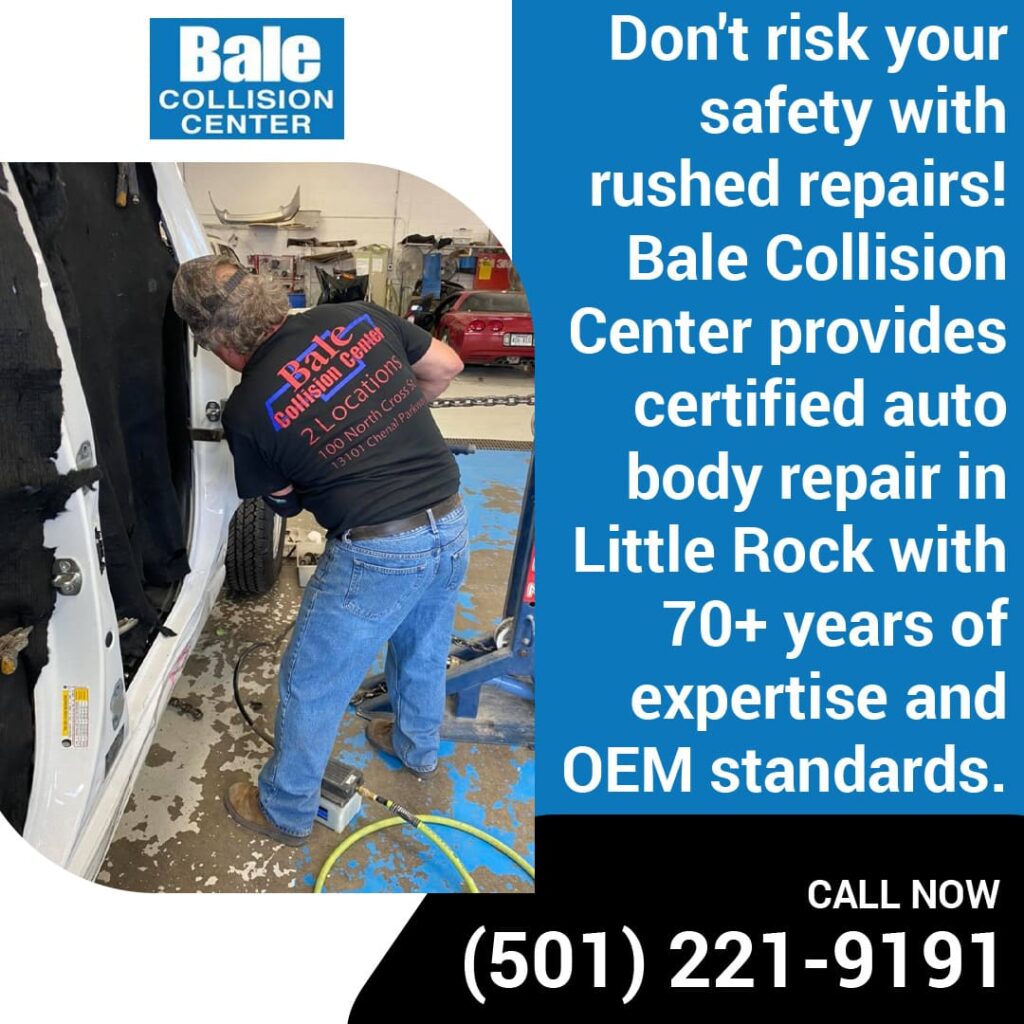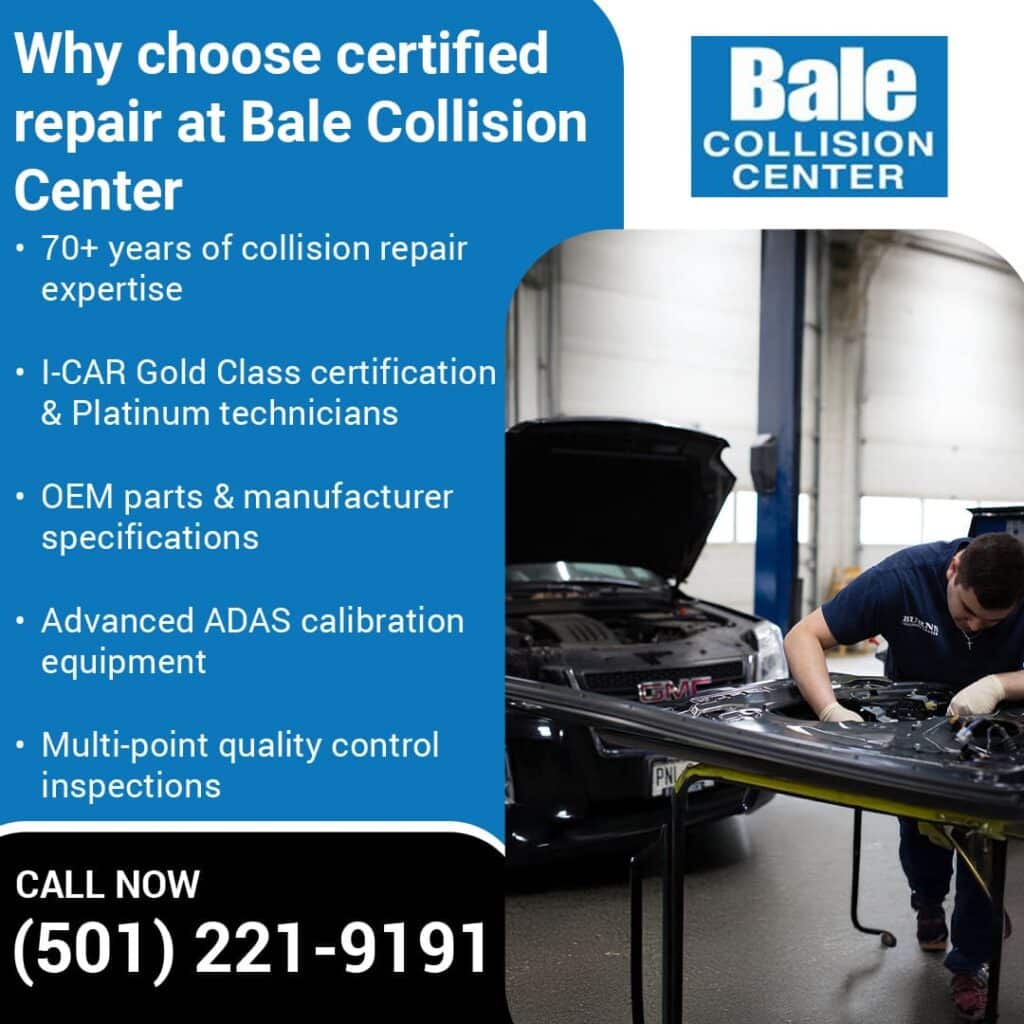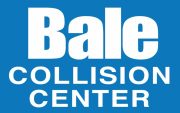When your vehicle gets damaged in a collision, the instinct is to get it repaired as quickly as possible. You need to get back to work, pick up the kids, and return to your daily routine. While speed might seem like an important factor when choosing an auto body shop, prioritizing fast turnaround times over quality auto body repair can lead to serious consequences that cost you more money, compromise your safety, and reduce your vehicle’s value.
Understanding why quality car body repair takes time is important for making informed decisions. At Bale Collision Center (Chenal), we’ve been helping families navigate these decisions for decades. Today’s vehicles demand specialized knowledge, advanced equipment, and precise procedures that cannot be rushed without sacrificing quality. Our auto body shop in Chenal Parkway, Little Rock, AR, combines efficiency with the uncompromising quality that modern vehicles require.

Factors Affecting Repair Completion Time
The timeline for proper auto body repair varies based on the extent of damage, vehicle complexity, and the thoroughness of the repair process. Minor car body repair projects like dent removal or a quick bumper touch-up can often be completed within 1 to 2 days. However, if your car has heavier damage like a bent frame, damaged panels, or has been through a serious collision, you’re looking at 7 to 14 days or more. Several factors influence repair timelines and explain why quality work cannot be rushed:
Thorough Damage Assessment
Professional shops must conduct detailed evaluations before beginning work, which includes identifying visible damage, uncovering hidden problems, and creating comprehensive repair plans. What initially appeared to be a simple two-day job might require additional time when technicians discover further damage during disassembly.
Parts Availability and Quality
Quality repairs often require OEM or high-grade aftermarket parts that may take several days to order and receive, especially for newer or less common vehicle models. Shops that promise immediate repairs often compromise by using inferior parts or skipping necessary components entirely.
Material Curing Requirements
Paint systems, adhesives, and other materials require specific curing periods to achieve the best strength and durability. This is particularly true in car refinishing, where proper drying times directly affect the quality of the final result.
Quality Control Processes
Reputable auto body services implement multiple inspection points throughout the repair process. This systematic approach catches issues early but requires additional time compared to shops that only inspect completed work after everything is finished.
Dangers of Rushing Auto Body Repairs
When auto body shops prioritize speed over quality, several serious problems can emerge that affect your vehicle’s safety, appearance, and long-term reliability. Choosing certified auto body repair services becomes important when you understand these potential issues.
Compromised Vehicle Safety
Modern vehicles incorporate advanced safety systems, structural elements, and electronic components that require precise repair procedures. Deviating from these procedures can result in compromised vehicle safety. Rush repairs often skip critical safety calibrations, structural reinforcement steps, and proper welding procedures.
Improper structural repairs can affect how your vehicle performs in future collisions. Frame misalignment, inadequate reinforcement, and substandard welding can all compromise the vehicle’s ability to protect occupants during accidents. These issues may not be immediately apparent, but they can have catastrophic consequences later.
Paint and Finish Defects
Large drips and runs are clear signs of a rushed paint job. They occur when paint is applied hastily and too thick. When examining your repaired vehicle, you might notice color-matching problems where metallic paint finishes show color fade because repainted parts contain different metallic flake concentrations compared to the original paint.
Surface imperfections, such as bumps from dirt and dust that have been painted over, indicate the car wasn’t properly cleaned before painting. Poor clear coat application results in diminished gloss, poor durability, and premature paint failure when adequate preparation isn’t completed.
Structural and Mechanical Problems
Auto body shops that rush through car body repair to meet tight deadlines may overlook critical repairs, resulting in incomplete work. Panel misalignment becomes evident when doors, hoods, and trunk lids don’t fit properly. Frame issues arise from inadequate straightening procedures that subsequently affect vehicle handling and cause premature tire wear.
Electrical problems develop when damaged wiring or sensors aren’t properly repaired or calibrated during the restoration process, leading to malfunctioning safety systems and dashboard warning lights. These mechanical complications often surface months after the initial repair, requiring additional work to correct the oversight and restore proper vehicle operation.
Hidden Damage Oversights
Sometimes surface damage conceals more serious underlying issues. Shops focused on quick turnarounds may not thoroughly investigate hidden damage, leading to incomplete repairs that cause problems later. This approach often results in additional repair needs and higher long-term costs.
Importance of Manufacturer Repair Standards
Engineering-Based Repair Guidelines
Original Equipment Manufacturer (OEM) repair procedures are detailed guidelines provided by vehicle manufacturers that specify the best practices for repairing vehicles after damage. These procedures make sure that repairs restore vehicles to their original safety and performance specifications.
Rather than arbitrary requirements, these represent engineering-based instructions that account for specific material properties and thicknesses, structural load paths and crumple zones, adhesive and welding specifications, heat treatment requirements, and electronic system calibrations. Each element works together to maintain the vehicle’s original design integrity.
At Bale Collision Center, we strictly follow these OEM repair guidelines for each of our auto body services. Our technicians are trained to access and interpret manufacturer specifications, ensuring that each repair meets the exact engineering standards originally designed for your vehicle.
Advanced Safety System Protection
Automotive technology is evolving each year, and following OEM repair procedures has become more critical. Modern vehicles incorporate numerous advanced safety systems that require precise handling during repairs.
Advanced Driver Assistance Systems (ADAS) work in conjunction with multiple airbag systems to protect occupants during collisions. Electronic stability control and collision avoidance systems monitor vehicle performance continuously, while backup cameras and sensors provide drivers with critical safety information. Each system requires specific repair and calibration procedures that maintain proper operation, and shortcuts in these areas can render safety systems ineffective or cause them to malfunction when needed most.
Our auto body shop in Chenal Parkway, Little Rock, AR, is equipped with the latest ADAS calibration equipment and diagnostic tools necessary to properly restore these advanced safety systems. Bale Collision Center’s certified auto body repair technicians receive ongoing training on the latest automotive technologies to make sure your vehicle’s safety systems function exactly as the manufacturer intended.
Legal and Financial Protection
The primary reason to perform repairs according to OEM procedures is liability protection. Should something go wrong and damage or injuries result, repair shops and their staff could be found liable if they failed to follow manufacturer recommendations.
Additionally, repair procedures must be performed according to the original equipment manufacturer’s service specifications. If it is not available, auto body shops must make proper repairs following specifications generally accepted by the repair industry to maintain structural integrity and vehicle safety.
Vehicle Value Protection
Repairs done according to OEM specifications help preserve vehicle value by maintaining original condition. This is important for resale and can also impact insurance considerations. Moreover, many vehicle warranties require repairs to be performed according to the manufacturer’s specifications to remain valid.
Recognizing Poor Quality Repair Work
Recognizing substandard repair work helps you avoid accepting inadequate repairs and protects your investment. Several warning signs indicate rushed or poor-quality collision repairs.
Visual Quality Problems
Paint Issues That Signal Rushed Work
Paint quality problems become apparent through various visual indicators that suggest rushed work. The most obvious signs include overspray, paint drips, or an orange peel texture that creates a bumpy surface resembling orange skin. These problems typically indicate rushed painting processes where proper masking and application techniques were skipped to save time.
Color matching presents another challenge that reveals hasty workmanship. Color variations between repaired and original panels stand out particularly on metallic and pearl finishes, where matching requires precise technique and patience that rushed shops simply don’t invest. A dull appearance or visible sanding marks underneath the clear coat indicate improper application that compromises both appearance and long-term durability.
Panel Fit and Surface Quality
Panel alignment issues often result from hurried work where technicians don’t take time for proper fitting and adjustment. Professional car body repairs result in body panels that fit together seamlessly without gaps, and doors that close with the same feel and sound as before the accident.
Surface quality problems extend beyond paint to the underlying bodywork itself. Properly repaired fenders, bumpers, and body panels should feel smooth to the touch without indentations, waves, or other irregularities that indicate insufficient preparation time was invested in the repair process.
Functional Performance Issues
Mechanical Operation Problems
Beyond visual problems, rushed repairs often create functional issues that become apparent during vehicle operation. All mechanical components should work exactly as they did before the accident, but hasty repairs frequently overlook these critical details. The most common issues include doors, windows, or trunk mechanisms that require extra force or don’t operate smoothly.
Electrical System Malfunctions
Modern vehicles contain extensive electrical networks that require careful attention during repairs. Warning lights that appear after repairs, malfunctioning sensors, or safety systems that don’t respond properly typically result from shortcuts taken during restoration. These electrical issues can compromise vehicle safety and often require additional diagnostic time to identify and correct.
Why Proper Repairs Take Time
Understanding modern collision repair complexity helps explain why quality work cannot be rushed without compromising results.
Thorough Damage Evaluation
Professional car body repair begins with a detailed damage evaluation that goes far beyond visible problems. This assessment includes:
- Panel and component removal to assess hidden damage that might not be apparent from external inspection
- Computerized structural measurements to verify that the vehicle’s frame hasn’t been compromised in ways that could affect safety or handling
- Electronic system evaluation to determine whether safety components have been damaged and need repair or replacement
- Detailed repair planning that addresses all identified issues to prevent surprises during the repair process
- Accurate timeline and cost estimation based on the complete scope of necessary work
Multi-Step Repair Process
Quality repairs involve multiple sequential steps, each with specific requirements that cannot be rushed.
- Structural repair – Frame straightening, panel replacement, and structural reinforcement using precise measurements and specialized techniques.
- Bodywork preparation – Proper surface preparation, filler application, and smoothing with required curing time between applications
- Paint preparation- Surface cleaning, priming, and preparation stages that cannot be rushed without affecting paint adhesion and appearance
- Paint application – Specific environmental conditions, professional application techniques, and proper curing periods for durable results
- Final assembly – Careful alignment, calibration of electronic systems, and thorough testing of all components to verify correct operation.
Quality Materials and Methods
Using proper materials and following correct procedures takes additional time but provides benefits that justify the investment. Long-term repair durability comes from using materials that match or exceed original specifications rather than cheaper alternatives that may fail prematurely. Proper adhesion and compatibility between components result from following the manufacturer’s procedures that account for how different materials interact. Compliance with safety and warranty requirements protects both the vehicle owner’s investment and provides legal protection for the repair facility.
Bale Collision Center’s Approach to Quality and Efficiency

At our auto body shop on Chenal Parkway, Little Rock, AR, we understand the importance of getting your vehicle back on the road promptly while never compromising safety or quality. Our approach balances efficient processes with uncompromising quality standards, drawing on seven decades of proven experience since 1952.
Seven Decades of Proven Experience
We have developed refined auto body services that maximize efficiency without cutting corners. Through decades of experience, we’ve learned where time can be saved through better organization and where additional investment is needed for proper car body repair. This experience has taught us that quality and efficiency work together rather than against each other when proper systems are in place.
Advanced Equipment and Technology
Our advanced equipment allows us to work more efficiently while maintaining the highest quality standards. Computer-controlled frame measurement systems provide the accuracy needed for proper structural repairs, while advanced BASF waterborne paint systems deliver precise color matching with environmental responsibility.
ADAS calibration equipment allows us to properly restore safety system functionality, and efficient workflow systems minimize delays without rushing critical steps that could compromise quality.
Certified Auto Body Repair
Our I-CAR Gold Class certification and Platinum-level certified technicians make sure that every auto body repair follows current industry best practices. This training investment allows our team to work efficiently while maintaining compliance with OEM repair procedures.
We keep customers informed throughout the repair process with detailed initial assessments, regular progress updates, clear explanations of any additional work discovered, and final walkthroughs for complete satisfaction.
Choose Professional Auto Body Repair in Chenal Parkway, Little Rock, AR
Quality car body repair protects your safety and helps maintain your vehicle’s value. At Bale Collision Center, we deliver reliable auto body services with consistent quality. Our certified technicians follow OEM-approved procedures, use advanced equipment, and apply proven methods developed over more than seventy years in business. We work with all insurance companies to keep the process straightforward while completing every repair to the highest standards.
Don’t risk your safety or investment by choosing speed over quality. Contact Bale Collision Center today at (501) 221-9191 for expert auto body repair that’s done right the first time.. You can also email us at bccwlr@baleautomotive.com for more information.
